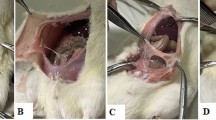Abstract
This study was conducted to determine the probability of adhesion formation with certain materials after abdominopelvic surgery, and to assess the effectiveness of adhesion-preventing agents. The study included 2 phases. In the first phase of the study, 50 rats that had been divided into 5 groups were examined. Group 1 served as the control group. In group 2,2 mL blood was taken from the femoral vein of the rat; in group 3,0.0625 g talcum powder was mixed with 2 mL saline; in group 4, 2 mL ileal content was identified; and in group 5, 2 mL cecal content had spilled into the peritoneum. In the second phase of the study, 50 rats that had been divided into 5 groups were examined. Ileal content was the leading cause of intraperitoneal adhesions in the first phase; in the second phase, in group 1, 2 mL ileal content and 5 mL povidone-iodine (10%) were used; in group 2,2 mL ileal content and 5000 units aprotinin were mixed with 5 mL saline; in group 3, 2 mL ileal content and 25 IU heparin (5000 IU/L) were mixed with 5 mL saline; in group 4,2 mL ileal content and 5 mL 32% dextran 70 were combined; and in group 5, 2 mL ileal content was used together with 5 mL Ringer’s lactate. On postoperative day 14, the rats were killed with the use of high-dose intramuscular ketamine, and necropsies were performed on all rats. Adhesions were most often established because of ileal and cecal contents. Blood and talcum powder produced less adhesion formation. Heparin and 32% dextran 70 were significantly more effective at preventing adhesion formation due to ileal contents. Intraperitoneal heparin and 32% dextran 70 may be particularly valuable for the prevention of adhesions due to intestinal content in cases with no contraindications.
Similar content being viewed by others
Rerefences
Risberg B. Adhesions: preventive strategies.Eur J Surg Suppl. 1997;(577):32–39.
Liakakos T, Thomakos N, Fine PM, Dervenis C, Young RL. Peritoneal adhesions: etiology, pathophysiology, and clinical significance.Dig Surg. 2001;18:260–273.
Van Der Krabben AA, Dijkstra FR, Nieuwenhuijzen M, Reijnen MM, Schaapveld M, van Goor H. Morbidity and mortality of inadvertent enterotomy during adhesiotomy.Br J Surg. 2000;87:467–471.
Nair SK, Bhat IK, Aurora AL. Role of proteolytic enzyme in the prevention of postoperative intraperitoneal adhesions.Arch Surg. 1974;108:849–853.
Galili Y, Ben-Abraham R, Rabau M, Klausner J, Kluger Y. Reduction of surgery induced peritoneal adhesions by methylene blue.Am J Surg. 1998;175:30–32.
Sow M. A classic cause, still not widely known, of postoperative peritoneal adhesions: talc.Rev Fr Gynecol Obstet. 1970;65:659–660.
Janik JS, Nagaraj HS, Groff DB. Prevention of postoperative peritoneal adhesions: efficacy of povidone.Arch Surg. 1982;117:1321–1324.
Chalkiadakis GE, Kostakis A, Karydakis P, et al. Effect of aprotinin on fibrinopurulent peritoni tis in rats.Am J Surg. 1985;150:550–553.
De Vriese AS, Mortier S, Cornelissen M, et al. The effects of heparin administration in an animal model of chronic peritoneal dialysate exposure.Perit Dial Int. 2002;22:566–572.
Di Zerega GS, Campeau JD. Use of instillates to prevent intraperitoneal adhesions: crystalloid and dextran.Infertil Reprod Med Clin North Am. 1994;5:463–478.
Becker JM, Dayton MT, Fazio VW. Prevention of postoperative abdominal adhesions by a sodium hyaluronate-based bioresorbable membrane: a prospective, randomized, double blind, multicenter study.J Am Coll Surg. 1996;183:297–306.
Diamond MP, Linsky CB, Cunningham T. Synergistic effects of Interceed (TC7) absorbable barrier.Infertil Reprod Med Clin North Am. 1994;5:485–550.
Haney AF, Doty E. Murine peritoneal injury and de novo adhesion formation caused by oxidized-regenerated cellulose (Interceed [TC7]) but not expanded polytetra-fluoroethylene (Gore-Tex Surgical Membrane).Fertil Steril. 1992;57:202–208.
Vigond MN, Whawell SA, Thompson JN, Dudley HA. Peritoneal fibrinolytic activity and intraabdominal adhesions.Lancet. 1990;335:1120–1122.
Doodey K, Dunn RC, Buttiom VC. Recombinant tissue plasminogen activator reduces adhesion formation in a rabbit uterine horn model.Fertil Steril. 1989;51:509–512.
Larsson B, Lalos O, Marsk L, et al. Effect of intraperitoneal instillation of 32% dextran 70 on postoperative adhesion formation after tubal surgery.Acta Obstet Gynecol Scand. 1985;64: 437–441.
Author information
Authors and Affiliations
Corresponding author
Rights and permissions
About this article
Cite this article
Parsak, C.K., Satar, S., Akcam, T. et al. Effectiveness of treatment to prevent adhesions after abdominal surgery: An experimental evaluation in rats. Adv Therapy 24, 796–802 (2007). https://doi.org/10.1007/BF02849972
Issue Date:
DOI: https://doi.org/10.1007/BF02849972




